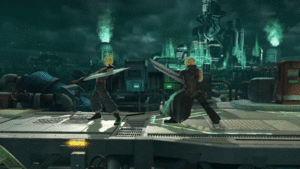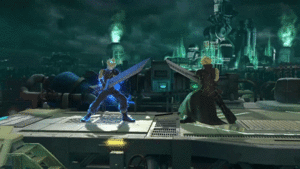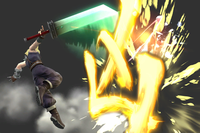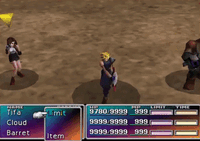Cross Slash: Difference between revisions
(→Overview: correct me if I'm wrong, but "radical" is usually associated with components of a character, like 亻being the male radical of 你, 他, etc. Kanji is definitely more accurate.) Tag: Mobile edit |
|||
| Line 11: | Line 11: | ||
==Overview== | ==Overview== | ||
Cloud slashes the | Cloud slashes the kanji {{ja|凶|kyō, fierce}} on his opponent. | ||
Cross Slash is a [[natural combo]] of three parts. | Cross Slash is a [[natural combo]] of three parts. | ||
Revision as of 05:47, September 13, 2024
| Cross Slash | |
|---|---|
Cloud using the normal and Limit Break versions of Cross Slash. | |
| User | Cloud |
| Universe | Final Fantasy |
Cross Slash (凶斬り, Misfortune Cutter) is Cloud's side special move.
Overview
Cloud slashes the kanji 凶 on his opponent.
Cross Slash is a natural combo of three parts.
- The first attack is a downward single-handed reap with a step forward that deals 4% damage.
- The second part is a two-handed swing downward in the other direction, dealing 3% damage and forming an X shape.
- The third segment is an automatic series of three slashes: two ground-level slashes in a fanning motion from left to right, then ending with an outward waving slash after a full spin, for 3%, 3%, and 6% damage.
If every hit connects, the five slashes deal a total of 19% damage while drawing the kanji 凶 (wicked, misfortune, or bane) through the air.
While this move is fast enough to use as a punish option and deals good damage with moderate knockback, it deals poor shield damage and shield stun, making it unsafe to use on shields; if any part of the move hits a shield, it is quite easy for the defender to retaliate, especially after the final part. Additionally, there is a small pause before the third segment of the move, which often causes extremely light and/or damaged enemies to get knocked out before the move is complete.
As with all natural combos, the player must press the relevant button after each step to continue execution of the move. However, unlike all other such attacks, the player is not allowed to continue the move unless it hits something: Cloud will only perform the first slash repeatedly if the move whiffs regardless of what the player does, and if the opponent escapes the second hit, the third step cannot be used.
The Limit Break version of the move involves Cloud unleashing the entire sequence at high speed, regardless of whether it hits anything or whether the player makes additional inputs. These slashes deal much more damage (27% total) and greater knockback than the base version of the move, with the final hit's hitbox also becoming slightly larger.[1] The camera will also zoom in on the hit fighter if the final hit connects while time slows down for a split second, similar to Little Mac's KO Uppercut. As Limit Cross Slash possesses very fast startup, a large hitbox, surprisingly low ending lag, and deals high shield damage, it is often considered one of Cloud's most effective and all-purpose Limit Break special moves.
Cross Slash is one of the few attacks in the entire Smash series that acts differently depending on orientation. Due to the move spelling out a real kanji symbol, the move cannot simply be mirrored, meaning Cloud performs a slightly different animation depending on which way he is facing.[2] While the differences are negligible, they do have some competitive applications. If Cloud is facing left, the move starts lower, meaning it can more easily hit smaller opponents. If Cloud is facing right, the move starts higher, meaning it becomes a more effective anti-air attack. If two Clouds were to use Cross Slash against each other on the exact same frame, the left-facing Cloud would win the exchange due to the hitbox reaching the opponent first.
Instructional quote
| Executes an attack that can be expanded into the full combo with two follow-up button presses. |
Customization
Special Move customization was added in Super Smash Bros. 4. These are the variations:
- Cross Slash: Default.
Like the other DLC characters, Cloud lacks custom move variations.
Origin
Cross Slash is Cloud's second level 1 Limit Break in Final Fantasy VII, which he learns after performing his initial Limit Break, Braver, eight times. It deals 3.25 times the damage of a normal physical attack to one enemy and inflicts paralysis. The usual animation for the attack shows him performing three strikes as opposed to the four strokes needed to write the kanji (Smash Bros. instead has him perform a total of five slashes). However, in some instances, such as in the Kingdom Hearts series, the kanji visual may be absent. In Smash 4, it uses a similar design to the original Final Fantasy VII, while in Ultimate, its design is based on its appearance in Dissidia Final Fantasy. The animation of the last three hits of Cross Slash in Smash is based on its animation in the 1998 fighting game Ehrgeiz, which featured several Final Fantasy VII characters, including Cloud, as guest fighters.
Also in some forms of media (such as in the Kingdom Hearts series and even Final Fantasy VII itself), the name is written with a hyphen ("Cross-slash").
Gallery
Cloud using Cross Slash on Luigi in Super Smash Bros. for Nintendo 3DS.
Cloud using the Limit Break-boosted Cross Slash on Ganondorf.
Cross Slash in Super Smash Bros. for Wii U.
Limit Break Cross Slash in Super Smash Bros. for Wii U
Cloud using Cross Slash on Diddy Kong on the Umbra Clock Tower.
Cross Slash as shown by the Move List in Ultimate.
Names in other languages
Trivia
- Like Little Mac's KO Uppercut, the camera zoom effect from a Limit Break Cross Slash will not appear if Cloud is hit on the exact frame the move connects against an opponent.










